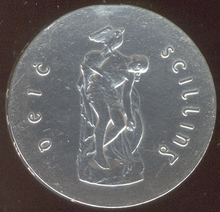
The standard circulating coinage of the United Kingdom, British Crown Dependencies and British Overseas Territories is denominated in pennies and pounds sterling, and ranges in value from one penny sterling to two pounds. Since decimalisation, on 15 February 1971, the pound has been divided into 100 (new) pence. Before decimalisation, twelve pence made a shilling, and twenty shillings made a pound.

The British two pound coin (£2) is a denomination of sterling coinage. Its obverse has featured the profile of Queen Elizabeth II since the coin’s introduction. Three different portraits of the Queen have been used, with the current design by Jody Clark being introduced in 2015. The reverse design features Britannia.
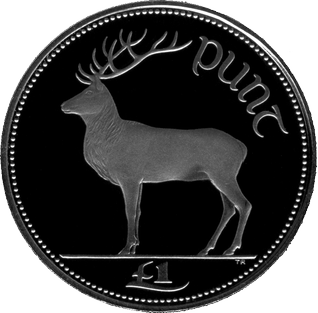
The pound was the currency of Ireland until 2002. Its ISO 4217 code was IEP, and the symbol was £ The Irish pound was replaced by the euro on 1 January 1999. Euro currency did not begin circulation until the beginning of 2002.

Decimal Day in the United Kingdom and in Ireland was Monday 15 February 1971, the day on which each country decimalised its respective £sd currency of pounds, shillings, and pence.

The pound was the currency of Australia from 1910 until 14 February 1966, when it was replaced by the Australian dollar. Like other £sd currencies, it was subdivided into 20 shillings, each of 12 pence.
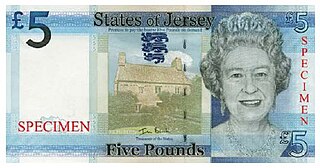
The pound is the currency of Jersey. Jersey is in currency union with the United Kingdom, and the Jersey pound is not a separate currency but is an issue of banknotes and coins by the States of Jersey denominated in sterling, in a similar way to the banknotes issued in Scotland and Northern Ireland. It can be exchanged at par with other sterling coinage and notes.
The pound is the currency of the Isle of Man, at parity with sterling. The Manx pound is divided into 100 pence. Notes and coins, denominated in pounds and pence, are issued by the Isle of Man Government.
The Saint Helenapound is the currency of the Atlantic islands of Saint Helena and Ascension, which are constituent parts of the British Overseas Territory of Saint Helena, Ascension and Tristan da Cunha. It is fixed at parity with sterling, and so both currencies are commonly accepted and circulated within Saint Helena. It is subdivided into 100 pence.
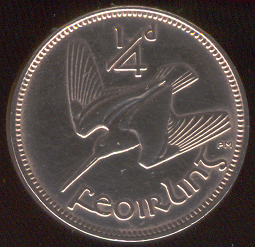
The farthing was the lowest value coin of the pre-decimal Irish pound, worth a quarter of a penny, 1⁄48 of a shilling or 1⁄960 of a pound. The coin had lost much of its value through inflation long before decimalisation in 1971, and during the 1960s no farthings were produced for general circulation; those minted in 1966 were produced for collectors' sets.
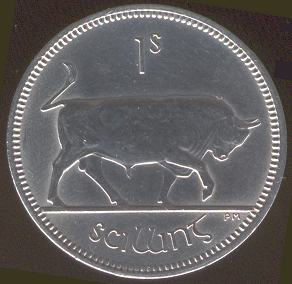
The shilling (1s) coin was a subdivision of the pre-decimal Irish pound, worth 1⁄20 of a pound. Worth 12d or half of a Florin.
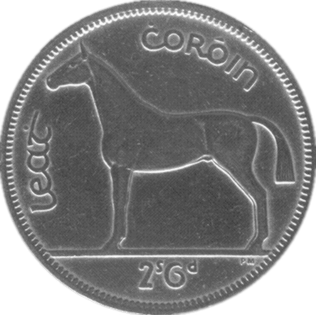
The half crown coin was a subdivision of the pre-decimal Irish pound, worth 1⁄8 of a pound. The half crown was commonly called "two and six" due to its value of two shillings and sixpence.
There have been three sets of coins in Ireland since independence. In all three, the coin showed a Celtic harp on the obverse. The pre-decimal coins of the Irish pound had realistic animals on the reverse; the decimal coins retained some of these but featured ornamental birds on the lower denominations; and the euro coins used the common design of the euro currencies. The pre-decimal and original decimal coins were of the same dimensions as the same-denomination British coins, as the Irish pound was in currency union with the British pound sterling. British coins were widely accepted in Ireland, and conversely to a lesser extent. In 1979 Ireland joined the Exchange Rate Mechanism and the Irish pound left parity with sterling; coin designs introduced after this differed between the two countries.

The British sixpence piece, sometimes known as a tanner or sixpenny bit, was a denomination of sterling coinage worth 1⁄40 of one pound or half of one shilling. It was first minted in 1551, during the reign of Edward VI, and circulated until 1980. The coin was made from silver from its introduction in 1551 until 1947, and thereafter in cupronickel.
The coins of the South African rand are part of the physical form of South Africa's currency, the South African rand.
The coins of the Cypriot pound are part of the physical form of former Cypriot currency, the Cypriot pound. They have been issued since coming under British rule in 1878, until Cyprus' adoption of Euro in 2008.
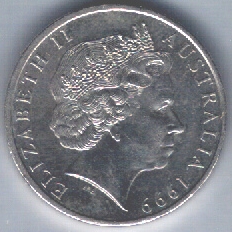
The twenty-cent coin of the Australian decimal currency system was issued with conversion to decimal currency on 14 February 1966, replacing the florin which was worth two shillings, a tenth of a pound.
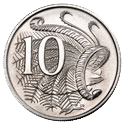
The Australian ten-cent coin is a coin of the decimal Australian dollar. When the dollar was introduced as half of an Australian pound on 14 February 1966, the coin inherited the specifications of the pre-decimal shilling; both coins were worth one twentieth of a pound and were called "bob". On introduction it was the fourth-lowest denomination coin. Since the withdrawal from circulation of the one and two cent coins in 1992, it has been the second-lowest denomination coin in circulation.
The coins of the New Zealand dollar are used for the smallest physical currency available in New Zealand. The current denominations are ten cents, twenty cents, fifty cents, one dollar and two dollars. The $1 and $2 coins are minted in a gold colour, the 20c and 50c coins are silver colour and the 10c coin is plated in copper.
The New Zealand fifty-cent coin is a coin of the New Zealand dollar. It was the largest by denomination, diameter and mass to have been introduced on the decimalisation of the currency on 10 July 1967, replacing the pre-decimal crown coin. A total of 81,585,200 pre-2006 50 cent coins were issued, with a total value of $40,792,600.00
The Semi-centennial of the Easter Rising in Ireland occurred in 1966. Many events took place to mark the events of 1916.
